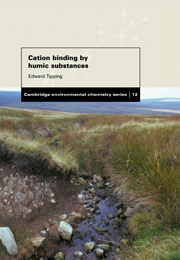Book contents
- Frontmatter
- Contents
- Preface
- 1 Introduction
- 2 Humic substances – a brief review
- 3 Environmental solution and surface chemistry
- 4 Proton dissociation from weak acids
- 5 Metal–ligand interactions
- 6 Methods for measuring cation binding by humic substances
- 7 Quantitative results with isolated humic substances
- 8 Cation binding sites in humic substances
- 9 Parameterised models of cation–humic interactions
- 10 Applications of comprehensive parameterised models
- 11 Predictive modelling
- 12 Cation–humic binding and other physico-chemical processes
- 13 Cation binding by humic substances in natural waters
- 14 Cation binding by humic substances in soils and sediments
- 15 Research needs
- References
- Index
12 - Cation–humic binding and other physico-chemical processes
Published online by Cambridge University Press: 18 August 2009
- Frontmatter
- Contents
- Preface
- 1 Introduction
- 2 Humic substances – a brief review
- 3 Environmental solution and surface chemistry
- 4 Proton dissociation from weak acids
- 5 Metal–ligand interactions
- 6 Methods for measuring cation binding by humic substances
- 7 Quantitative results with isolated humic substances
- 8 Cation binding sites in humic substances
- 9 Parameterised models of cation–humic interactions
- 10 Applications of comprehensive parameterised models
- 11 Predictive modelling
- 12 Cation–humic binding and other physico-chemical processes
- 13 Cation binding by humic substances in natural waters
- 14 Cation binding by humic substances in soils and sediments
- 15 Research needs
- References
- Index
Summary
Humic substances undergo a number of physico-chemical interactions other than cation binding. They include aggregation, adsorption, the binding of hydrophobic organic compounds, photochemical reactions, and involvement in mineral precipitation and dissolution. In laboratory studies, conditions will usually be arranged to keep ‘background’ conditions simple, to focus on the interaction of interest. In the natural environment, however, some or all of the processes, including cation binding, proceed in parallel, and must influence one another. The purpose of the present chapter is to consider how cation binding influences these other interactions, and how they in turn may influence cation binding.
The conformation of humic matter
When cations are bound by humic substances, changes may occur in the conformation of the humic molecules. For example, it can be envisaged that the formation of multidentate complexes involving separate parts of the molecule may lead to a more compact structure. Another possibility is that, by reducing the net humic charge, cation binding leads to the reduction of repulsive interactions, again leading to compaction. The sensitivity of humic acid size and shape to cation binding has been emphasised by Swift (1989a), as discussed in Chapter 2. The more flexible and ‘diffuse’ is the conformation of the material before cation binding, the greater will be the changes in conformation on binding. Being smaller, fulvic acids have fewer opportunities to undergo conformational change.
Evidence for conformational change induced by proton binding comes from viscosity measurements (Ghosh & Schnitzer, 1980; Avena et al., 1999).
- Type
- Chapter
- Information
- Cation Binding by Humic Substances , pp. 262 - 287Publisher: Cambridge University PressPrint publication year: 2002

